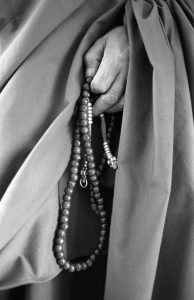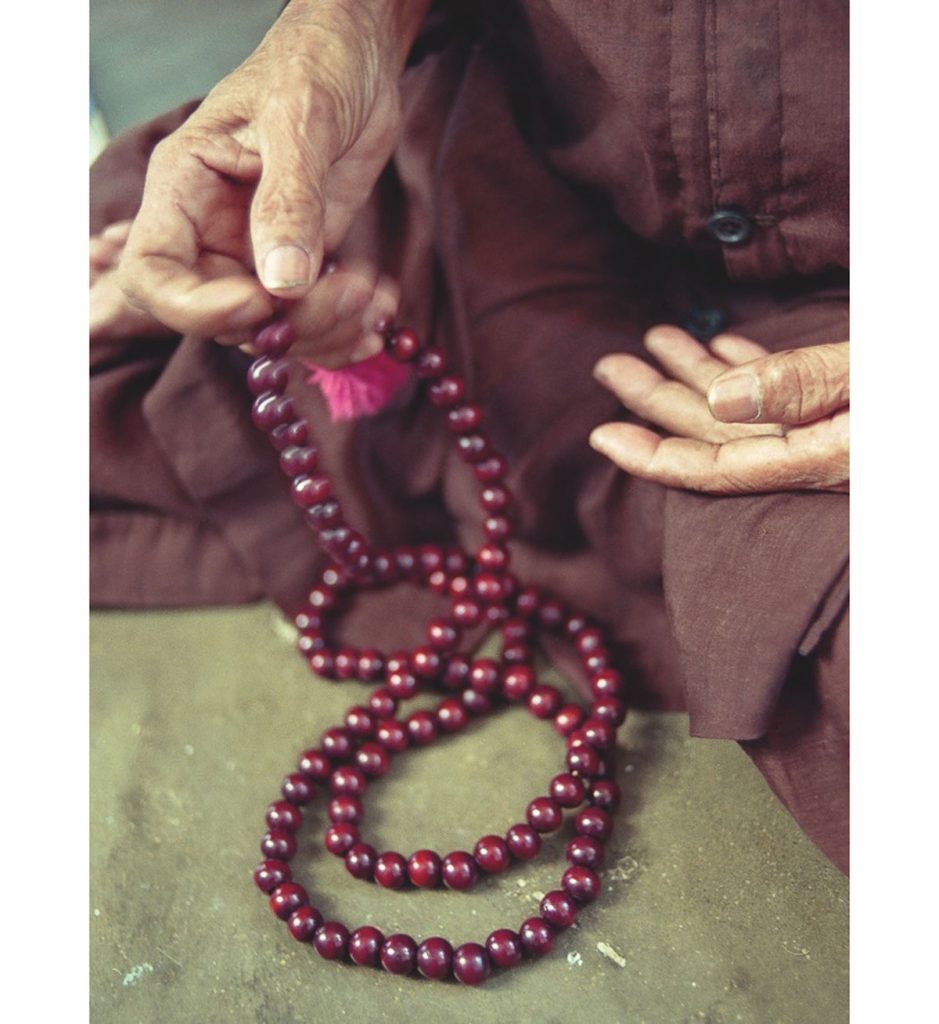Take up a Buddhist mala, and right away you notice how good it feels in your hands. The same is true of the prayer beads of any religious tradition. First, there is the soothing feel of the beads themselves, which only increases as they become smoother or darken with use. Then there is what they symbolize—the tangible link to an age-old tradition. Run a string of prayer beads through your hands and you are touching an ancient practice. Yours are only the most recent set of fingers to caress such beads, and others will take them up later, after you are gone.
On a more literal note, the mala is also a kind of Buddhist robe. Worn about the neck or wrist, it is, after a monk’s shaved head, the most recognizable sign of Buddhist affiliation—especially for laypeople who might not otherwise be identified as such. In the beginning, in fact, prayer beads were mostly designed for the layperson’s use. Monks now carry them, but if we follow the various bead traditions back far enough, we usually find that they were a way of adapting monastic discipline to the limits and demands of nonmonastic life. The Catholic “rosary,” so named when travelers to India mistranslated the Sanskrit word japamala as “rose beads,” is a perfect example. Its one hundred and fifty Hail Marys (completed by going through the beads three times) were a substitute for observing the monastic hours, in which all one hundred and fifty psalms were chanted. Likewise, the fifteen “mysteries,” episodes from the lives of Jesus and Mary, were intended to function as a summary of the Gospel for ordinary illiterate people who were unable to read the Bible on their own. Even in the Buddhist tradition, the first prayer beads were not intended for monks’ use.
According to a popular legend on the origins of Buddhist mala practice, King Vaidunya once said to the Buddha: “In recent years, disease and famine have swept my country. The people are distressed, and I worry about this night and day without interruption. Ours is a pitiful condition. The totality of the dharma is too profound and extensive for us to practice, given these circumstances. Please teach me just the main point of the dharma so that I may practice it and teach it to others.”
The Buddha replied: “King, if you want to eliminate earthly desires, make a circular string of 108 bodhi seeds and, holding them always to yourself, recite, ‘I take refuge in the Buddha. I take refuge in the dharma. I take refuge in the Sangha.’ Count one bead with each recitation of these three.”
Related: The Three Gems
This is the earliest tale of Buddhist mala practice, and it was clearly intended for those who, unlike members of the Buddha’s monastic assembly, could not abandon the worries of secular life. That mala beads later came to be used by the monks themselves probably testifies to their effectiveness in calming the kinds of worries that afflict us all, monk and lay alike. When questioned in an interview, even the Dalai Lama admits to being attached to his beads.
After nearly thirty years of using and making the prayer beads of various religious traditions, I have come to a simple conclusion: All beads are worry beads—from the Pope’s rosary all the way down to those little wrist malas, sometimes popularly referred to as “Power Bracelets,” worn by Buddhists and non-Buddhists alike. People of every religious tradition will claim that their beads are for praying—for appealing to a higher power, for collecting the spirit or concentrating mind—and while this is indisputably true, that is not their primary purpose. Beads are for worry. They answer a human need so basic it actually precedes a religious consciousness—and that is to fret over things. The Buddhist mala acknowledges this. It is a way of engaging our worries, a way of combining the universal need for talismanic objects with the kind of repetitive movements that calm the body and mind. The difference between the Buddhist mala and the various Western-style rosaries is simply that it makes this explicit in the symbolism of its beads.
A Buddhist mala typically consists of 108 beads, one for each of the delusions (call them worries) that afflict human life. I am often asked how that number was arrived at, and the answer, although somewhat convoluted mathematically, makes sense from a Buddhist point of view. There are six varieties of delusion that can occur when we experience an object of awareness: delusion via the eyes, the ears, the nose, the tongue, the body, or the mind. Each of these objects can in turn be perceived in the past, the present, or the future, making for eighteen possibilities in all. Multiply these by the two conditions of heart (pure and impure) and again by the three possible sentiments with regard to any of those sense objects (like, dislike, and indifference), and the number of possibilities for delusion is found to be 6 x 3 x 2 x 3 . . . or 108. There are other ways of calculating that number, but in most cases the gist is the same. For a Buddhist, delusion is the only legitimate source of worry. Worrying about money or health is, by comparison, relatively pointless. There will never be enough money in the world (that seems to be the point of money), and our health is guaranteed to fail in the end, no matter what we do. The wordless message of the Buddhist mala is “Don’t worry about things; worry about the fact that you are so worried all the time, and address the root of that.” The mala is a teaching in itself.
No matter which particular recitation it is being used for, the mala contains a full course of spiritual lessons. To begin with, every Buddhist tradition stresses that the beads must be cared for as if they were a precious sutra or a Buddhist robe. This makes a literal kind of sense if we consider the fact that we use them to recite mantras, often considered the essence of the sutras in which they appear. Then there is the fact that, unlike the Catholic rosary, the mala is meant to be worn when not in use. Thus, to use a mala is both to take up a spiritual text and to clothe oneself in the truth of the Buddha Way. And then there is the curious matter of the “guru” bead. The larger, three-holed bead at the end of a mala is the Buddhist equivalent of the crucifix on a Catholic rosary. It is the teacher—and the teaching— we keep coming back to with every cycle we pray.
The mala contains a full course of spiritual lessons.
At some point in their religious observances, most Mahayana Buddhists recite some variation on the bodhisattva vows, the second of which is “No matter how inexhaustible delusions are, I vow to vanquish them all”—a paradox at best, at worst an impossible task. But the mala offers a valuable clarification on this point, for it is basically a circle. In the course of reciting a round of mantras, one begins and ends with the guru bead. As a rule we never cross that bead in our counting. Rather, if we want to continue beyond a single cycle, we stop at the guru bead and count the beads back in the opposite direction, repeating this same cycle for as long as we wish to practice. In this way, we find that delusions truly are inexhaustible. Delusion is the realm we live in; delusion is fundamentally what we are. To overcome this, once and for all, is to pass beyond this life. When we have done that, finally, we enter the timeless realm of the Buddha.

What is most peculiar about mala practice is that the beads never take us there. Always we stop short of the Buddha realm and turn back the other way. This may seem fatalistic on its surface, but there is a deep wisdom in this simple ritual, for even though he eventually passed into the extinguished, blown-out-candle state of nirvana, the Buddha realized his enlightenment as a human being and lived in peace with all other beings in this world. He is the Tathagata, or the “Thus Come One,” not the Thus Gone.
We are not called upon as Buddhists to deny the world, and certainly not to escape from it. We are called to live with it, and to make our peace with all that is. In Buddhist terms, that peace is called Tathagata. The Thus Come One is enlightened as he is, not as he would wish himself to be. There is no escaping this. The world of worries we wish to escape from in the beginning of Buddhist practice is found to be enlightenment itself in the end. We don’t understand this, of course, and so we keep striving for a distant, idealized kind of Buddhahood, only to reach its threshold and be turned back the way we came. In this way, we receive the teaching of the Buddha with every mala we say.
That is what the beads have taught me. Now, after many years of handling them, taking in their teachings through the palm of my hand, I am occasionally able to recognize a little of that teaching when I see it manifested in others. There is the Tibetan mother of a friend of mine, dispossessed of her homeland, happily walking through the town where I live, an enormous goiter swelling above the neckline of her traditional dress. She fingers her beads continuously, smiling all the while. She speaks little English, but as I witness her reach the end of her mala and happily twist it about in her hand to finger its beads back the other way, I see that she is at peace in the world, as though she had actually spoken the words aloud. Buddha. Dharma. Sangha. The teachings are all there. She carries them. And when she isn’t carrying them, she wears them on her sleeve.
Thank you for subscribing to Tricycle! As a nonprofit, we depend on readers like you to keep Buddhist teachings and practices widely available.
